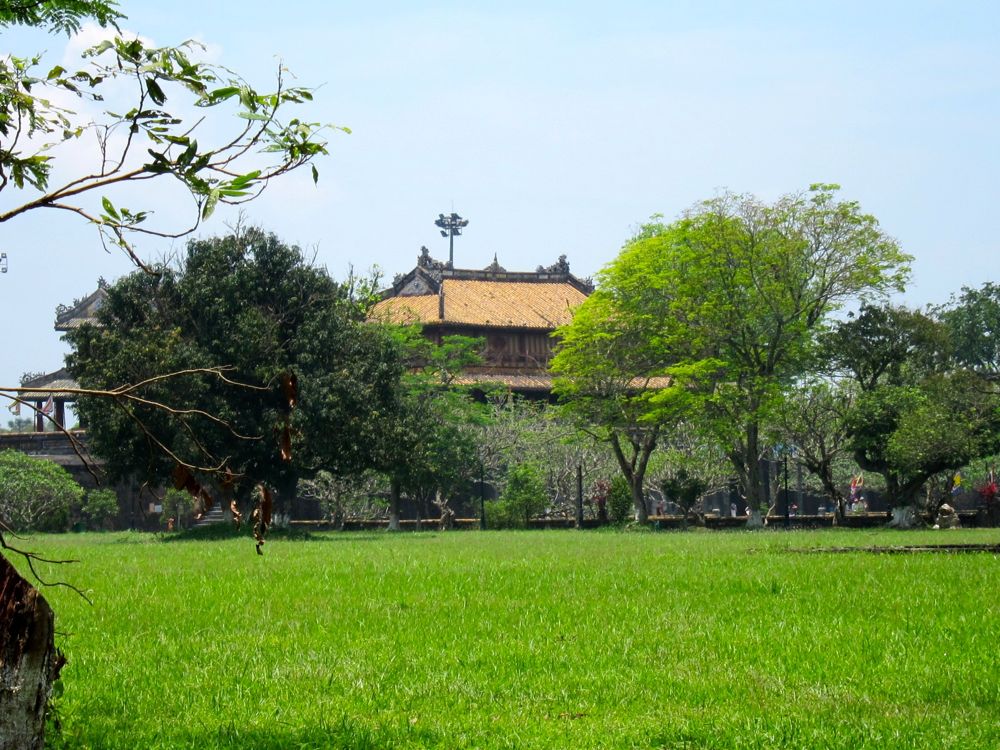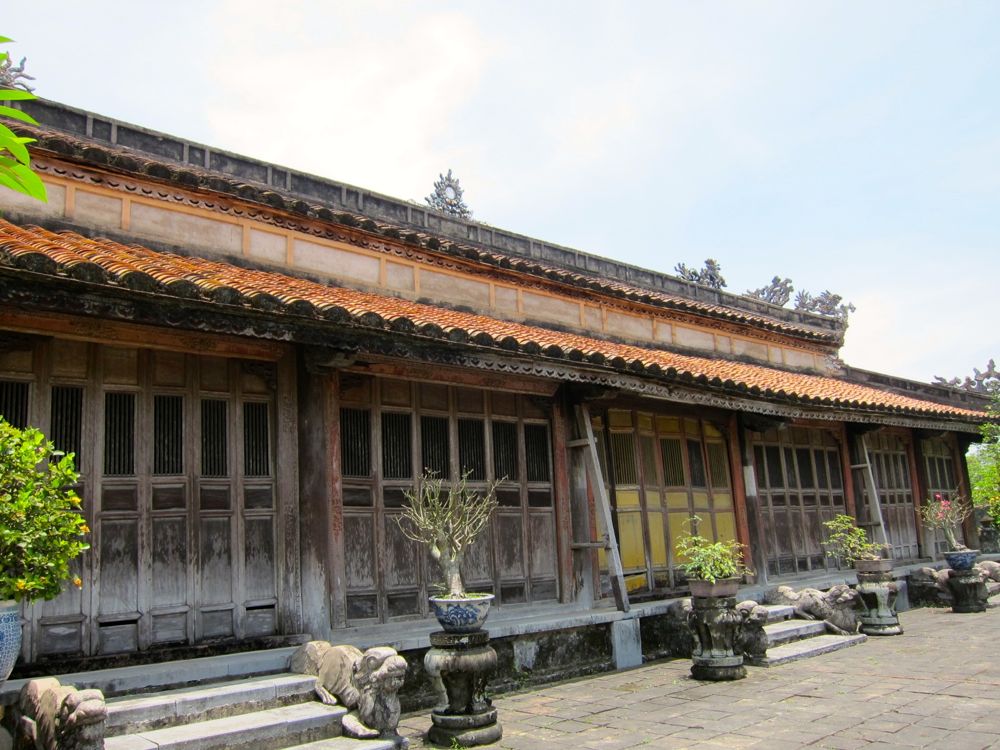Hue: The Ancient Imperial Capital of VietnamLocated on the Perfume River, Hue's misty atmosphere reminds visitors of its once mysterious imperial past akin to China's forbidden city.
Hue was the center of the Nguyen dynasty, which ruled this place from 1558 to 1945. The legacy of this long reign left Hue with many places to explore and exciting things to do. Hue: The Former Royal City
Despite the influx of tourists, Hue has retained its charm as a quiet little town. But maybe not for long. Declared a UNESCO World Heritage in 1993, this former royal city of Vietnam just feted its two millionth tourist with flowers and gifts. Today, many more visit this charming ancient city. Though devastated during the Vietnam War (remember TET?), Hue still has a sampling of the Nguyen palaces, temples, pagodas, and the tombs of these early Vietnamese rulers.
Hue has been the seat of the powerful Nguyen rulers and has more than a few bastions of the later French rule of Indochine. Finding monuments and old buildings is rarely problematic, but a little effort is needed if you want the sense and feel of history.
Although we wanted to visit Hue because of its history, we were not there by choice. The gods must have listened as we missed our flight from Hoi An to Ho Chi Minh. Vietnam Airlines kept delaying flights in our itinerary, which was the worst because we finally decided to sleep in Hue after a full day's wait at the airport. Four flights, four disasters - a new record for us in entirely dysfunctional airlines! The first delay was significant as we could go around and see the city. We rented a car and just went for an instant tour of the must-see places in Hue. It was a glimpse at Vietnam's past, and we lucked out with the driver, so it was impressive, informative, and entertaining. Top Things to Do in Hue
Because it was the ancient imperial capital of Vietnam, Hue is worth exploring. There are many places to explore and things to experience in the city. Here are a few: 1. Explore the Citadel and the Forbidden City If you are interested in history, make Hue's Citadel your top destination. The pagodas, temples, and imperial tombs are worth seeing after you have explored. The Citadel and the Forbidden City will take almost a day to explore. Started in 1804, the Citadel is a 2-meter thick, 10 km long wall within the Imperial Enclosure. Towering over the Citadel is the Flag Tower, and on its gates are the Nine Holy Cannons, the symbolic protectors of the kingdom. The Forbidden Purple City
The four cannons near Ngan Gate represent the four seasons, and the five next to the Quang Duc Gate represent the five elements: water, earth, wood, fire, and metal. At the center of the Imperial Enclosure is the Forbidden Purple City, a walled compound solely for the use of the emperor, and around its perimeter are residences and temples primarily for Royalty and their court. In the center of the enclosure is the Forbidden City, a walled compound solely for the emperor's use. Take a good look at the main entrance, Ngo Mon Gate. It faces the 37—meter—high Flag Tower. To either side of the Flag Tower are the Nine Holy Cannons; four represent the four seasons, and the five represent the five elements: earth, water, fire, metal, and wood.
Another place of interest in the imperial city is the Thai Hoa Palace, a big hall with an ornate timber roof used for imperial receptions and coronations. Just behind the palace are the Halls of the Mandarins, used as offices. There are more places to explore, such as the To Mieu Temple, the Dien Tho Residence, the Troung San Residence, and the Royal Theatre.
2. Visit the Other Monuments of Hue Spend another day at the pagodas, foremost of which are the Bao Quoc (1670) and the Dieu De National Pagoda (1841). Don't miss the Thiun Mu Pagoda, initially founded in 1641, and the Tu Hieu Pagoda, where the famous master, Thich Nhat Hanh, entered to become a monk. Worth a visit is the National School, a secondary school founded in 1896 by Vietnamese president Ngo Dinh Diem's father, Ngo Dinh Kha, and boasts as students some of Vietnam's prominent figures, such as the famous Vietnamese general, Vo Nguyen Giap, Pham Van Dong, former North Vietnam's premier, Do Muoi, former communist party secretary general and prime minister. Even Ho Chi Minh studied in the school for a while.
Also, explore along the Perfume River's banks the Nguyen rulers' magnificent tombs. 3. Cruise the Perfume River
After a long walk around the citadel, other things beckon. If you are more adventurous, drive to Da Nang or Hoi An for dinner and fun. Or head to the Beach. The closest is about 45 minutes. Have a good dip in the ocean. Cruising the Perfume River is quite enjoyable. A journey along the Perfume River will bring you to the Thien Mu Pagoda and several royal tombs, including that of Tu Duc, Minh Mang, and Khai Dinh. The boat trip ranges from $3 upward. You can also charter a boat. 4. Be there for the Hue Festival - A showcase of Hue Culture
This biennial festival has taken on the world stage with visiting artists from many countries presenting their work and the Vietnamese in Hue showcasing their royal theatre, music, dance, art, and puppetry, primarily performed at the Hue Nguyen court in the past. As in the past, most festival activities are at the Hue Citadel. 5. Enjoy Hue's Royal Court Music - Nha Nhac Performance
Hue recently commemorated the ten years of the inscription of this Royal Court Music in the list of the intangible cultural heritage of humanity. This performance used to be a national event during the Nguyen reign. Today, the concert takes place on a platform about 2 kilometers west of the Imperial Palace. This platform was built by the early Nguyen rulers using soil from different parts of the country. With bands playing court music, a formal procession of kings and mandarins, recently played by actors dressed in the costumes of the Nguyen rulers and accompanied by horses and elephants, walked from the palace to the Pavilion for the rituals. Locals lit incense at the platform. Other Exciting Things to Do in Hue
Whatever else you do in Hue, don't forget to try these:
Hue in History
Until 1945, Hue has been the seat of the powerful Nguyen dynasty founded by Emperor Gia Long. As early as the late 1700, these powerful Nguyen rulers built the city but it did not take much for the French to strip it of anything of value and sideline the Nguyen rulers from governance. So, Hue lost its prominence in Vietnam until 1968 when The TET offensive took the world's attention and placed Hue once more in the international map. As the only city in South Vietnam to be occupied by the Vietnamese National Liberation Front, it became the scene of a vicious battle in the TET offensive when South Vietnamese and US forces fought hard to take it back. It was destroyed and with its monuments, more than ten thousand people killed including 150 US Marines. The Siege of Hue was one of the longest and bloodiest battles of the Vietnam War. How to Go to Hue
You can fly to Hue from Hanoi or Ho Chi Minh City and pray your flights will not be messed up. If you are already in Da Nang or Hoi An, Hue is an easy drive. You can take a day trip to Hue from those places. From Laos, there is a border crossing, Lao Bao-Dansavahn, which is about 152 kms. from Hue. You can get visas to Laos at this border but you can't get a Vietnamese visa. Arrange for this beforehand in your own country or from Laos. It is easy to get a visa from any Vietnamese embassy. OK...if you are a die hard back packer, you can get buses from almost anywhere to anywhere in the Mekong countries for a pittance, but for the...ahhhhhh.......mature tourist, the plane should be the answer.
Check out these other Interesting Articles on Vietnam:
|
|












